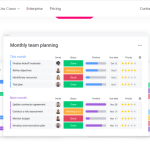Today, it’s difficult not to hear about big data and data-driven decision-making. The term alone has become something of a buzzword in business recently and for very good reason. Data allows business owners to leverage the endless digital insights that are now available at their fingertips and embrace the power of data-driven business intelligence to make more informed decisions that are better for business growth and evolution, plus increasing profits. By understanding how to both measure and analyze your data accurately and using the right reporting tools, you will find it easier to do data-driven decision-making that will help your business thrive.
Today, data-driven business decisions are more important than ever. And while sometimes it’s best to go with your gut, a huge majority of business decisions need to be based on facts, figures, and metrics that tie in with your goals and aims. This provides you with something solid to back up your business operations and management aims.
What is Data-Driven Decision Making?
Key performance indicators (KPIs) and measurable goals are key factors in data-driven decision-making for the business. Facts and patterns gained from these insights are analyzed, and they are then put to use in order to develop activities and strategies designed to be the most beneficial for the business. Rather than relying on guesswork, data-driven decision-making allows business professionals to leverage verified and analyzed data when working towards main business goals and objectives.
However, it’s important that you are set up to extract information from your data that is genuinely valuable. In order to do this, the data you gather should be accurate and relevant to the goals you want to influence using it. Once, the tasks of collecting and analyzing data insights were all-encompassing and often led to decision-making delays; however, today, business intelligence software has made making data-driven decisions a much easier process. Even users who do not have deep technical expertise are able to easily extract insights from data using these programs.
Quantitative Data
Quantitative data analysis has a strong focus on statistics and numbers with factors such as standard deviation, median, and other descriptive statistics playing a very big role. This type of analysis is measured, rather than observed, in order to help business owners and managers make more informed business decisions based on the numbers. Quantitative data analysis is often used by those who are looking for facts and figures that they cannot ignore in order to make the best decision in the interest of the business.
Qualitative Data
On the other hand, qualitative data analysis focuses on data that cannot be defined by simply looking at metrics, numbers, and statistics. This type of data could be gathered from conversations, interviews, anecdotes, and interviews, for example. Unlike quantitative data which is based on measurement, qualitative data is analyzed through observation.
Why is Data-Driven Decision Making So Important for Today’s Businesses?
Some of the main reasons why data is so important in business decision-making to include continuous growth and consistency. Data analysis allows companies to choose new business opportunities with a higher chance of success, generate a higher level of revenue, and prepare the business for future growth by more accurately predicting future trends. Using data in decision-making will keep your business heading in the right direction, optimizing your current and future operational efforts and making it easier to produce insights that can be quickly acted upon in the best interests of the company. This results in a situation where a business is in a better place to evolve and grow over time along with being more adaptable to changing situations.
Since the digital landscape is ever-evolving and changing, businesses need to utilize data to make informed decisions that allow them to move and grow along with the changing environment. Data-driven business decisions often have the power to either make or break a company, which is why data visualization is so important. It’s an artistic science that allows companies to better connect with and engage with others; click here to find out more about the artistry of analytics.
Tips for Better Data-Driven Business Decision Making
Using data to drive your business decisions will automatically make them more accurate and successful. However, a data-driven decision-making strategy should be accompanied by various strategies and actions in order to get the most from the process and propel your business toward success using data. Keep these practical tips in mind:
Define Your Objectives
Using data to drive your decisions can be rendered pointless if you are not sure which objectives you are working towards. Before beginning data analysis, defining objectives allows you to get the most out of the data that you have gathered which allows you to avoid following the hype rather than focusing solely on the unique needs and requirements of your business and customers. Define clear KPIs in order to get a better look at exactly what you’re using the data to measure.
Be Aware of Biases
A lot of the work that we do in our minds is not done consciously, which can sometimes make it difficult to check the logic that we use during the decision-making process. In some cases, you might even find that you end up seeing what you want to see from the data rather than what is actually in front of you. In this case, this is where the help of a good team who does not share your biases can come in handy. Everybody is biased in some way or another, but being aware that you may have certain biases can keep them in your conscious mind during the decision-making process and help you to limit the impact that they have on the overall result.
Find Unanswered Questions
Once you have clear goals and a clear strategy in mind, you will find it easier to reach your business goals when you search out questions that have so far gone unanswered. Asking the right questions during the data analysis process makes it easier for teams to focus on the most relevant data, which in turn helps you speed the process up and avoid spending more than is necessary to get the results that you need.
Gather the Right Data
Gathering the right data is crucial to the analytical process. Data collection should begin as early as possible for any business. Regardless of how new your business is, starting to gather data as soon as possible will help you avoid a situation where you are relying too heavily on instinct and missing out on making the best decisions that are backed up by the numbers.
Carry Out In-Depth Analysis
Depending on the type of questions that you need to find answers for, it is likely that you will need to take some time to study the data that you have gathered in order to extract analytical reports and meaningful insights to support your decision-making process. For example, user feedback can be an incredibly useful tool for businesses that need to carry out a more in-depth analysis before making key decisions that are going to have an impact on the customer experience. Often, it’s important to have the context in order to use data as effectively as possible when making any decision that is going to impact your business or customers.
Consider Alternatives
It is fairly normal to be reluctant to consider alternatives, especially if a conclusion has been reached. But in the case of data analysis, it can often be very helpful to revisit and reevaluate the data a second time. Even if you are invested in the path that you have decided to take, it’s important to stay aware during every step of the process and revisit the data if you feel that it might not be the right direction after all. Spending some time to verify the data and make sure that you are tracking the correct metrics for your decision-making process can help you think outside of the box of your decision patterns and really put the data to use to make the right choices for your business.
Set Measurable Goals
Once your question, data, insights, and analytical tools have been put to work, now comes the most difficult part of actually making the decisions. It is at this point when you will need to apply everything that you have found from the data so far to the decision that you need to make. However, you will also need to ensure that any decision you make is not only informed by the data, but that it also aligns closely with the mission, values, and vision of the company – even if the data does not. Sometimes it’s important to get creative and make a decision that is not only supported by the data but supports the wider goals of the company. In order to do this, it’s a good idea to set measurable decision-making goals to make sure that you are moving in the right direction.
One way to achieve this is by enrolling in a Power BI course. Taking a Power BI course will equip you with the necessary knowledge and skills to leverage this powerful tool and enhance your data-driven decision-making capabilities, ultimately helping your business thrive in today’s data-centric landscape.
Today, data-driven decision-making has never been more important for companies that want to succeed. A Power BI Course can help you make better decisions faster.



